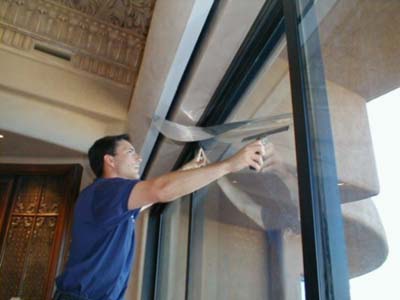
Getting residential window film installed on your home’s windows can do everything from slash your annual heating expenses to reduce glare and UV damage.
Window film is technically a laminate coating made from polyester. The reason polyester is used is that it blends with the natural clarity of your windows and retains its shape over time.
The film itself is only a few millimeters thick and it fits snugly on the interior side of your window with the help of some adhesive.
Dyed Window Film
A window film that is dyed (colored) prevents UV damage and glare just like sputtered or deposited film. The key difference is that dyed window film actually absorbs the harmful UV rays from the sun instead of deflecting or reflecting them.
There are many benefits to going with a dyed window film. Dyed window films come in a variety of colors to match your decor and their darker hue can actually prevent theft and enhance home’s privacy.
The downside to using a dyed window film is that by absorbing the sun’s rays instead of reflecting them the thermal heat (or thermal stress) can eventually wear down your home’s window and lead to breakage. This is very rare, though, and easily prevented with a professional installation.
Sputtered Window Film
Sputtered window film is also known as metalized window film because the window film includes various kinds of metals to help reduce the amount of UV radiation and glare that makes it way into your home.
In effect, the copper or aluminum that’s encased in sputtered window film reflects the sun’s rays and keeps your home safe and cool.
A side benefit of using sputtered window film is that during the frigid winter months, sputtered window film will help your home retain heat since these metals are great insulators.
The infusion of metal in sputtered window film is evenly layered across the film and non-obtrusive. Sputtered film is very common in residential applications and increasingly used in office buildings to reduce glare and cooling expenses.
Hybrid Window Film
Although some sources will tell you that there are only two distinct kinds of window film – those that absorb the sun’s rays (dyed window film) and those that reflect the sun’s rays (sputtered window film) – there is one other type of window film on the market today.
A hybrid window film actually gives you the best of both worlds. By both reflecting the sun’s rays and absorbing the remaining solar stress that can be placed on your windows, you can get along with a more mellow tint that still reduces the amount of heat making its way into your home.
Interested in window film for your home or office? Try Daystar Window Tinting!